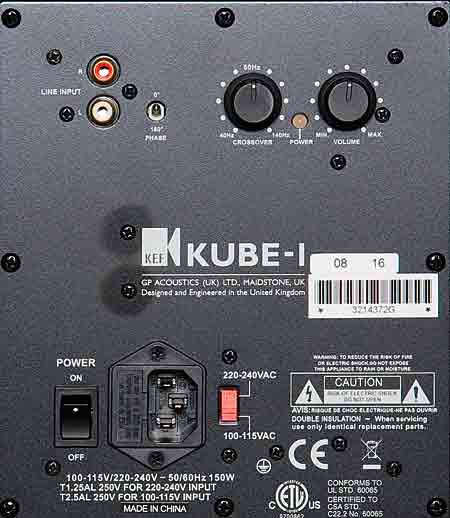KEF KHT1005.2 Speaker System Page 2
Scorpions and Fishhooks Coming for You
The DTS-HD Master Audio soundtrack of The Scorpion King is not noteworthy for its restraint. However, it does have one subtlety that comes up again and again—it inserts an almost subliminal choral texture into the instrumental score to indicate mystical events. Without the presentation that KEF’s coaxial array provides, I might have missed it. The soundfield was precise and well defined, albeit not airy or huge.
In more action-packed scenes, the tonal balance was more lightweight than I’d expect, even with such a compact sat/sub set and even with the sub crossover set at 120 hertz. I raised the receiver’s sub channel to its 0-decibel midpoint, 4 dB over its normal setting, and I turned the sub’s volume control from one-third to two-thirds of its maximum. Those two moves got me a little more bass solidity, but the lightweight feeling never totally abated.
The Dolby TrueHD soundtrack of I Know What You Did Last Summer starts out with a sinister cover of “Summer Breeze,” the Seals & Crofts song, and backs it up with a plot about guilty teens haunted by a merciless fisherman-killer. Whenever the remorseless reaper approaches someone with his giant fishhook, the soundtrack signals menace with a low rumbling of trombones. The KEFs spotlighted this brassy texture so well that I actually visualized the instruments. It was distracting but cool.

How shall I describe Weeds? Imagine Cheech & Chong humor in a soccer-mom TV series. Minor musical snippets became treats on the DTS-HD Master Audio core soundtrack. Each episode features someone different performing the opening song. It veers from Randy Newman plunking a piano to African pop and other approaches. Even the hard-core rock that punctuates the angry scenes grabbed me. The KEF speakers make toppy electric guitar sting like a buzz saw. This kind of programming—with a succession of intimate comic moments—was more suitable for the KHT1005.2 system than the epic sweep of an effects-laden, big-budget movie.
Where the Music Is
Where the Light Is: John Mayer Live in Los Angeles has a Dolby TrueHD soundtrack that the KEFs mined for every morsel of detail. In this three-act concert, Mayer starts with an unplugged segment, with one, two, and then three guitarists. Then he moves on to an electric power trio, and he finally ends with a big band. The mix delivers a lively top end but always stops short of abrasiveness. These qualities complemented the speakers’ high-frequency clarity. Mayer changes not only guitar sound, but guitars, with every song in the electric sets. And the KEFs diligently catalogued every tone color. Crowd noise was not just a wash, but a collage of thousands of audible sounds. I could even tell which audience members were sitting closest to the microphones.
Electric bass lines sounded subdued and not physically substantial, but the sub evenly rendered the pitches. That’s an advantage of a sealed enclosure—improved transient response, which many would describe as “less bloated.” The only thing I wanted a lot more of was the slam of Mayer’s two excellent drummers. They were both too obviously understated by the teeny satellites and restrained sub. But my compliments go to filmmaker Danny Clinch for documenting Mayer’s charisma while not neglecting his excellent band.
I went on (not for the first or last time) to Nick Drake’s Pink Moon. Drake’s LP is the only one I have ever bought, played, and immediately replayed in one sitting. The well-cared-for vinyl copy I pulled off the shelf was the same one that seduced me in college. I switched between stereo and the Dolby Pro Logic II Music mode. This revealed perfect timbre matching. The center’s coaxial driver array was identical to the other speakers, so it didn’t matter whether it was horizontal or vertical. The speakers emphasized Drake’s breathiness (he smoked) and de-emphasized his voice’s rich lower midrange and the bottom guitar strings. On-axis listening provided the best results—the voice thinned out off axis.
The orchestral pick was Johannes Brahms: Symphony No. 4, performed by Carlos Kleiber and the Vienna Philharmonic. This 1981 CD was a victim of early digital recording techniques, so the world’s best string section lost some of its luster, and the KEFs truthfully documented this loss. However, the recording of the strings was natural enough to highlight the speakers’ slight coaxial coloration. It wasn’t as crude as a cupped-hands effect, but it was evident in the opening movement. After that, my brain processed it out, and the powerful focus of the Uni-Q array took over as the dominant impression.
The KHT1005.2 is the baby in the KEF family. Like all the KEFs I’ve reviewed, it images like a champion, keeps up with dialogue, and can produce instrumental textures of startling vividness. Also, like all $800 speaker packages, it has its limitations, especially in bass weight and slam. I’d recommend it for a small room where larger speakers just aren’t suitable. Given the right salon and a decent receiver, it can be quite a scintillating entertainer.




























































